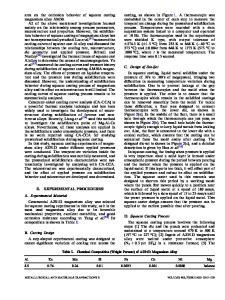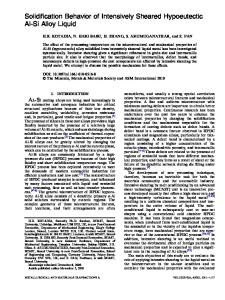Solidification Characteristics and Segregation Behavior of Cu-15Ni-8Sn Alloy
- PDF / 7,637,380 Bytes
- 13 Pages / 593.972 x 792 pts Page_size
- 14 Downloads / 273 Views
commercial Cu-Ni-Sn alloy, strengthened by spinodal decomposition,[1,2] has been paid much attention since it was designed by Bell Laboratory. There are four major market segments for Cu-Ni-Sn alloy products: oil and gas, aerospace, mechanical systems and electronics.[3,4] As one of the most potential substitutes for the toxic Cu-Be alloy, Cu-Ni-Sn alloy has also been widely used in electronic industry for bushings, bearings, springs, electronic connectors, etc., because of its high strength and elasticity, excellent wear resistance and other outstanding mechanical properties.[5] However, the previous study[6] revealed that a serious segregation phenomenon of the Sn element exists in the conventional casting process for Cu-15Ni-8Sn alloy, which results in the degradation of its mechanical property. Therefore, great efforts have been made in recent decades. It has been indicated that some techniques,
ZHONGKAI GUO, JINCHUAN JIE, SHICHAO LIU, JIAMING LIU, SHIPENG YUE, YUBO ZHANG, and TINGJU LI are with the Key Laboratory of Solidification Control and Digital Preparation Technology (Liaoning Province), School of Material Science and Engineering, Dalian University of Technology, Dalian 116024, Liaoning, China. Contact e-mail: [email protected]. Manuscript submitted August 29, 2019.
METALLURGICAL AND MATERIALS TRANSACTIONS A
such as powder metallurgy,[7] rapid solidification,[8,9] spray deposition[10] and so on, may have great potential in the manufacturing of Cu-Ni-Sn alloy, which can reduce the Sn segregation to a large degree. Although Cu-Ni-Sn alloy has been successfully prepared by the above-mentioned methods, it should be noted that the high cost and limited sample size have become great obstacles to industrial production and application. Nowadays, with the development of the aerospace, mechanical systems and electronic industries, large-sized Cu-Ni-Sn alloy ingots are urgently needed. Therefore, traditional casting is still the most appropriate preparation method for the industrial production of Cu-Ni-Sn alloy. It should be pointed out that the increase in the size of the ingot inevitably leads to different cooling rates at different positions inside the ingot. In this case, the solute redistribution occurs during solidification and finally results in the inhomogeneity of the chemical composition inside the ingot. To address this issue, a better understanding of the solidification characteristics of Cu-Ni-Sn alloy should be developed aiming to control the solidification process and obtain the anticipated microstructure. However, although the Cu-Ni-Sn alloy has been widely used for several decades, there is very limited available literature regarding its solidification characteristics and segregation behavior. Up to now, extensive studies on Cu-Ni-Sn alloy mainly focused on microstructure evolution,[11–14] mechanical
properties,[5,15–19] etc. Very few researchers paid attention to the solidification and segregation behavior of ternary Cu-Ni-Sn alloy under the conventional casting method. It is known that the segregation p
Data Loading...










